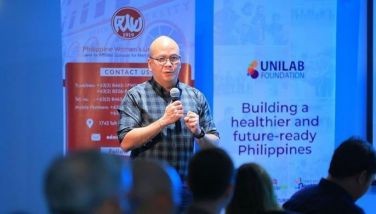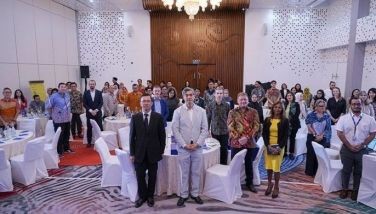Scientists harness rice genes in global battle vs poverty
December 1, 2003 | 12:00am
LOS BAÑOS, Laguna (AFP) — Clad in a white scrub suit and working behind air-tight double metal doors, Swapan Datta tends to designer rice that scientists say could save the human race, but which some fear is a potential monster.
The Indian biotechnologist’s potted plants look nothing out of the ordinary. But as the International Rice Research Institute (IRRI) has modified their genes, they are kept in a special greenhouse so they do not pollinate other plants.
The idea that nutrient-rich, yellow-tinged "golden rice" seeds are the culinary equivalent of the Frankenstein monster "doesn’t make any sense," Datta told reporters at the IRRI laboratory in the Philippines.
"So far no GMO (genetically modified organism) produced and released to the farmer has caused any risk or any adverse effect that’s known to us," the 51-year-old Calcutta native said. "Not a single case."
Ronald Cantrell, the American director-general of IRRI, said "the pace with which GMOs will have an impact on (rice) production will be dictated by public opinion and the interaction between science and public, much more than our acquisition of knowledge in getting that technology ready."
He said most of the debate on the supposed harmful effects of GMO in the United States and Europe had nothing to do with science.
Asia and Africa, the rice-eating half of the planet and home to most of its poor, "may be willing to accept certain risks that developed countries will not," Cantrell added.
As yields from one of the world’s most important cereals level off from dramatic 1960s gains, IRRI and other research institutions are employing transgenics as a new weapon to combat global poverty.
"There’s a lot fewer poor people in Asia today" compared to 43 years ago when IRRI began churning out high-yield rice varieties, said IRRI economist David Dawe.
But there are still "a lot of people out there who spend as much as 40 percent of their income on rice – not on any vegetable, not on any meat, not education, not trips to the doctor or medicine for the children," he said.
Amid flagging international donor support due to postwar rebuilding in Iraq and Afghanistan, Cantrell said IRRI would shift more of its limited resources to improving the nutritional quality of rice, a domesticated grass cultivated for more than 6,000 years.
A 10-year coordinated effort by IRRI, the private sector and a number of national scientific institutions has led to "golden rice," where three genes are manipulated to make them produce beta carotene, niacin, iron and other essential minerals in the seed.
"We have now some new tools, molecular tools that will allow us to manipulate germplasm in a way that would make significant changes in protein quality, changes in carbohydrate structure, carbohydrate types, all kinds of changes," Cantrell said.
"We are on the brink of making some changes we could only dream about."
Beta carotene, which the human body turns into Vitamin A that is stored in the liver, is present on rice leaves but not in the normal grain. Since humans do not eat grass, Datta said scientists "migrated" the gene into the "golden rice" seed.
Aside from beta carotene, IRRI cloned soybean genes to enrich the iron content of eight popular tropical Asian rice varieties.
Datta believes these will be available to ordinary Asian farmers and consumers in three or four years once governments adopt national biosafety guidelines.
It could have "tremendous impact" on nutrition for Asians, who eat steamed rice at least twice a day, he said.
The Indian biotechnologist’s potted plants look nothing out of the ordinary. But as the International Rice Research Institute (IRRI) has modified their genes, they are kept in a special greenhouse so they do not pollinate other plants.
The idea that nutrient-rich, yellow-tinged "golden rice" seeds are the culinary equivalent of the Frankenstein monster "doesn’t make any sense," Datta told reporters at the IRRI laboratory in the Philippines.
"So far no GMO (genetically modified organism) produced and released to the farmer has caused any risk or any adverse effect that’s known to us," the 51-year-old Calcutta native said. "Not a single case."
Ronald Cantrell, the American director-general of IRRI, said "the pace with which GMOs will have an impact on (rice) production will be dictated by public opinion and the interaction between science and public, much more than our acquisition of knowledge in getting that technology ready."
He said most of the debate on the supposed harmful effects of GMO in the United States and Europe had nothing to do with science.
Asia and Africa, the rice-eating half of the planet and home to most of its poor, "may be willing to accept certain risks that developed countries will not," Cantrell added.
As yields from one of the world’s most important cereals level off from dramatic 1960s gains, IRRI and other research institutions are employing transgenics as a new weapon to combat global poverty.
"There’s a lot fewer poor people in Asia today" compared to 43 years ago when IRRI began churning out high-yield rice varieties, said IRRI economist David Dawe.
But there are still "a lot of people out there who spend as much as 40 percent of their income on rice – not on any vegetable, not on any meat, not education, not trips to the doctor or medicine for the children," he said.
Amid flagging international donor support due to postwar rebuilding in Iraq and Afghanistan, Cantrell said IRRI would shift more of its limited resources to improving the nutritional quality of rice, a domesticated grass cultivated for more than 6,000 years.
A 10-year coordinated effort by IRRI, the private sector and a number of national scientific institutions has led to "golden rice," where three genes are manipulated to make them produce beta carotene, niacin, iron and other essential minerals in the seed.
"We have now some new tools, molecular tools that will allow us to manipulate germplasm in a way that would make significant changes in protein quality, changes in carbohydrate structure, carbohydrate types, all kinds of changes," Cantrell said.
"We are on the brink of making some changes we could only dream about."
Beta carotene, which the human body turns into Vitamin A that is stored in the liver, is present on rice leaves but not in the normal grain. Since humans do not eat grass, Datta said scientists "migrated" the gene into the "golden rice" seed.
Aside from beta carotene, IRRI cloned soybean genes to enrich the iron content of eight popular tropical Asian rice varieties.
Datta believes these will be available to ordinary Asian farmers and consumers in three or four years once governments adopt national biosafety guidelines.
It could have "tremendous impact" on nutrition for Asians, who eat steamed rice at least twice a day, he said.
BrandSpace Articles
<
>
- Latest
- Trending
Trending
Latest
Trending
Latest
Recommended































